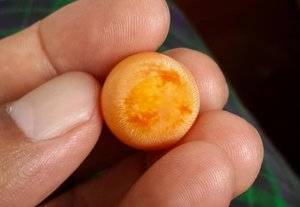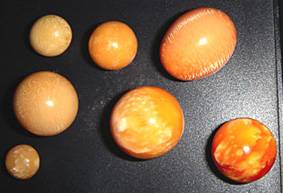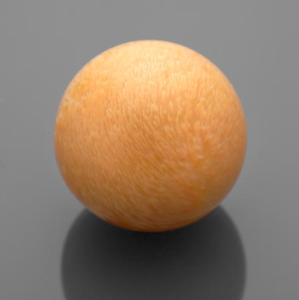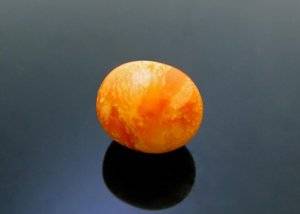demantoidz
Brilliant_Rock
- Joined
- Jun 25, 2019
- Messages
- 511
Hi, new account here but I've been a lurker for years.
It was difficult for me to find basic information on Melo pearls online. Finally I contacted GIA with some basic questions, and I figured someone, someday might find this info useful, so that is why I'm posting this. My question was forwarded to Manager of Visual Resources and they were very willing to help. I'm not sure where they got the info from (most likely a pearl expert or grader they had contact with).
Specifically, I was curious about a comment that GIA often leaves on Melo pearl reports, 'heavily polished'. This article mentions that the comment can mean that the entire surface of the pearl may be altered: https://www.gia.edu/gia-news-research/natural-shell-blisters-and-blister-pearls.
It got me wondering, since most melos you see out there are very round or occasionally other pleasing shapes, to what extent is their shape manipulated? Could intense polishing completely alter the pearl’s shape, from baroque to spherical?
First, I asked about the frequency and negative effects of heavy polishing and this was the response:
"In the experience of our lab, many porcelaneous pearls including Melo pearls are polished to improve surface appearance and/or minor surface blemishes. The degree of heavy polishing is stronger than the average polishing but does not affect the durability of the pearl. It is not considered a treatment and will elicit a statement in the comments section of the report. Heavily polished pearls usually have shiny and smooth surfaces with obvious polishing lines. Because GIA does not buy or sell Melo pearls, we can’t comment on the effect of value on Melo pearls that have been heavily polished."
Then, I asked about concerns that were written by a user on a different pearl forum, that some Melo ‘pearls’ may be carved from the Melo shell whorl, and that labs are lenient and may not differentiate between them. This seemed unlikely but I asked about it anyway. Below are my questions and their answers.
"1) Overall, do you think the poster's [the one mentioned in the previous paragraph] concerns are valid?
The poster makes good and not so good points. Some labs may be “lax” but GIA is among the most open on this subject. We state worked, heavily worked and heavily polished cases when observed. We are very aware that shell imitations may be submitted as “pearls” and it is usually not challenging to separate such pearls from true pearls. This is carried out through the observation of both the external and internal structures. Shell imitations usually show clear banding reflective of their formation, unlike the concentric formation of pearls.The spiral pattern on the whorl is unlike any structure seen in the pearls.
2) Can GIA identify reshaping and would this be explicitly written on a report or does it fall under the 'heavily polished' comment?
Shaped pearls (heavily worked[HW]) are identifiable and not called “heavily polished [HP]”. However, some HW pearls are also HP. GIA clearly states when a melo is HW and issues reports on such pearls identifying them as “Shape natural pearl(s) (see comments)”, with an additional comment stating that “The shape, surface and luster of [this/these] pearl(s) [has/have] been modified”.
3) Would a carved Melo shell whorl exhibit flame to the point of rivaling fine Melo pearls with good flame?
From our experience the whorls don’t show the marked flame pattern and hence the possible pseudo-chatoyancy that some pearls can exhibit. A lot don’t appear to show obvious flame patterns at all.”
If I ask more questions and get more answers, I’ll remember to post them here. I assume most here are not particularly interested in melo pearls, but maybe someone will find this basic but difficult to find info useful one day. My goal was to add a little unique information to this already informative forum.
It was difficult for me to find basic information on Melo pearls online. Finally I contacted GIA with some basic questions, and I figured someone, someday might find this info useful, so that is why I'm posting this. My question was forwarded to Manager of Visual Resources and they were very willing to help. I'm not sure where they got the info from (most likely a pearl expert or grader they had contact with).
Specifically, I was curious about a comment that GIA often leaves on Melo pearl reports, 'heavily polished'. This article mentions that the comment can mean that the entire surface of the pearl may be altered: https://www.gia.edu/gia-news-research/natural-shell-blisters-and-blister-pearls.
It got me wondering, since most melos you see out there are very round or occasionally other pleasing shapes, to what extent is their shape manipulated? Could intense polishing completely alter the pearl’s shape, from baroque to spherical?
First, I asked about the frequency and negative effects of heavy polishing and this was the response:
"In the experience of our lab, many porcelaneous pearls including Melo pearls are polished to improve surface appearance and/or minor surface blemishes. The degree of heavy polishing is stronger than the average polishing but does not affect the durability of the pearl. It is not considered a treatment and will elicit a statement in the comments section of the report. Heavily polished pearls usually have shiny and smooth surfaces with obvious polishing lines. Because GIA does not buy or sell Melo pearls, we can’t comment on the effect of value on Melo pearls that have been heavily polished."
Then, I asked about concerns that were written by a user on a different pearl forum, that some Melo ‘pearls’ may be carved from the Melo shell whorl, and that labs are lenient and may not differentiate between them. This seemed unlikely but I asked about it anyway. Below are my questions and their answers.
"1) Overall, do you think the poster's [the one mentioned in the previous paragraph] concerns are valid?
The poster makes good and not so good points. Some labs may be “lax” but GIA is among the most open on this subject. We state worked, heavily worked and heavily polished cases when observed. We are very aware that shell imitations may be submitted as “pearls” and it is usually not challenging to separate such pearls from true pearls. This is carried out through the observation of both the external and internal structures. Shell imitations usually show clear banding reflective of their formation, unlike the concentric formation of pearls.The spiral pattern on the whorl is unlike any structure seen in the pearls.
2) Can GIA identify reshaping and would this be explicitly written on a report or does it fall under the 'heavily polished' comment?
Shaped pearls (heavily worked[HW]) are identifiable and not called “heavily polished [HP]”. However, some HW pearls are also HP. GIA clearly states when a melo is HW and issues reports on such pearls identifying them as “Shape natural pearl(s) (see comments)”, with an additional comment stating that “The shape, surface and luster of [this/these] pearl(s) [has/have] been modified”.
3) Would a carved Melo shell whorl exhibit flame to the point of rivaling fine Melo pearls with good flame?
From our experience the whorls don’t show the marked flame pattern and hence the possible pseudo-chatoyancy that some pearls can exhibit. A lot don’t appear to show obvious flame patterns at all.”
If I ask more questions and get more answers, I’ll remember to post them here. I assume most here are not particularly interested in melo pearls, but maybe someone will find this basic but difficult to find info useful one day. My goal was to add a little unique information to this already informative forum.











300x240.png)